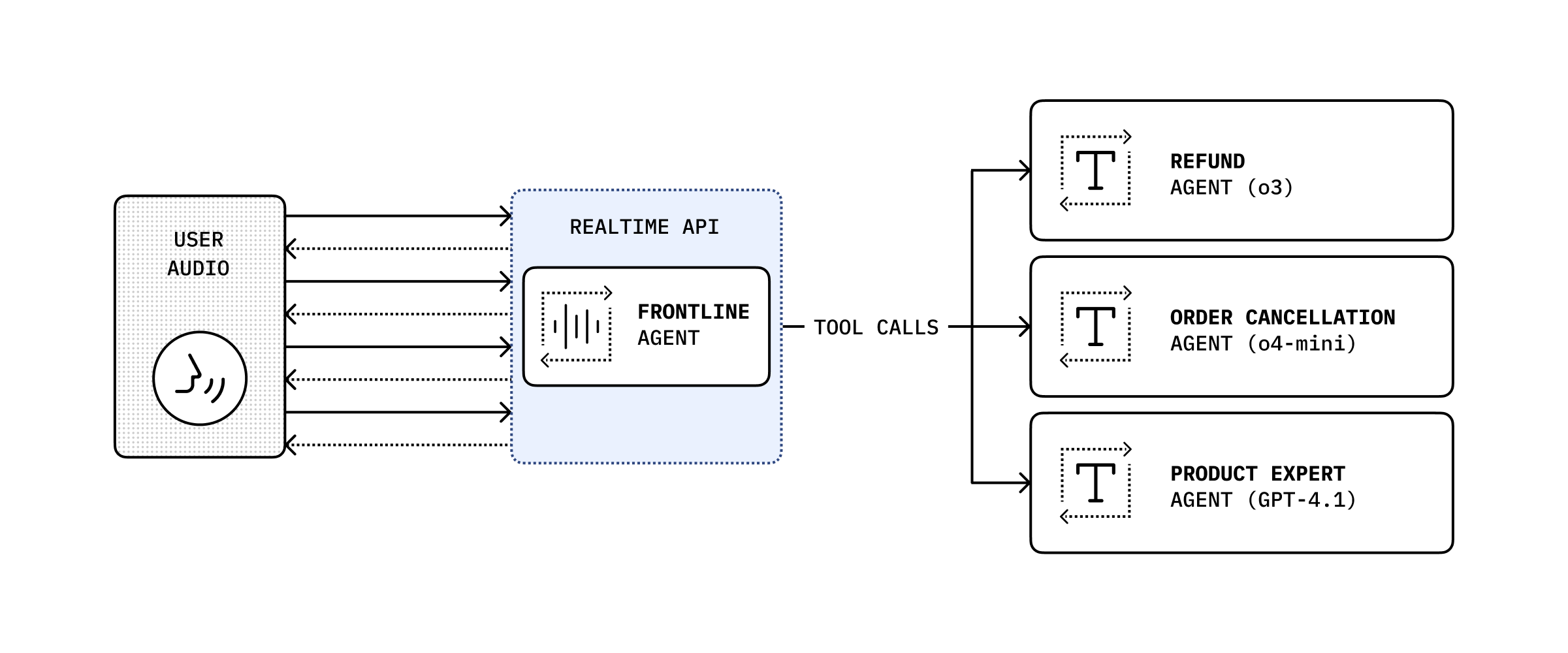构建语音智能体
某些传输层(如默认的 OpenAIRealtimeWebRTC)会自动为你处理音频输入与输出。对于其他传输机制(如 OpenAIRealtimeWebSocket),你需要自行处理会话音频:
import { RealtimeAgent, RealtimeSession, TransportLayerAudio,} from '@openai/agents/realtime';
const agent = new RealtimeAgent({ name: 'My agent' });const session = new RealtimeSession(agent);const newlyRecordedAudio = new ArrayBuffer(0);
session.on('audio', (event: TransportLayerAudio) => { // play your audio});
// send new audio to the agentsession.sendAudio(newlyRecordedAudio);你可以在构造时向 RealtimeSession 传入额外选项,或在调用 connect(...) 时进行配置。
import { RealtimeAgent, RealtimeSession } from '@openai/agents/realtime';
const agent = new RealtimeAgent({ name: 'Greeter', instructions: 'Greet the user with cheer and answer questions.',});
const session = new RealtimeSession(agent, { model: 'gpt-realtime', config: { inputAudioFormat: 'pcm16', outputAudioFormat: 'pcm16', inputAudioTranscription: { model: 'gpt-4o-mini-transcribe', }, },});这些传输层允许你传递任意与 session 匹配的参数。
对于那些新增且在 RealtimeSessionConfig 中没有对应参数的设置,你可以使用 providerData。传入 providerData 的任何内容都会作为 session 对象的一部分直接传递。
与常规智能体类似,你可以使用交接将智能体拆分为多个智能体,并在它们之间编排,以提升智能体性能并更好地限定问题范围。
import { RealtimeAgent } from '@openai/agents/realtime';
const mathTutorAgent = new RealtimeAgent({ name: 'Math Tutor', handoffDescription: 'Specialist agent for math questions', instructions: 'You provide help with math problems. Explain your reasoning at each step and include examples',});
const agent = new RealtimeAgent({ name: 'Greeter', instructions: 'Greet the user with cheer and answer questions.', handoffs: [mathTutorAgent],});与常规智能体不同,交接在实时智能体中会有些差异。执行交接时,正在进行的会话会更新为新的智能体配置。由于这一点,智能体会自动访问正在进行的对话历史,且当前不会应用输入过滤器。
此外,这意味着在交接过程中无法更改 voice 或 model。你也只能连接到其他实时智能体。如果你需要使用不同的模型,例如像 gpt-5-mini 这样的推理模型,你可以使用通过工具进行委托。
与常规智能体一样,实时智能体可以调用工具来执行操作。你可以使用与常规智能体相同的 tool() 函数来定义工具。
import { tool, RealtimeAgent } from '@openai/agents/realtime';import { z } from 'zod';
const getWeather = tool({ name: 'get_weather', description: 'Return the weather for a city.', parameters: z.object({ city: z.string() }), async execute({ city }) { return `The weather in ${city} is sunny.`; },});
const weatherAgent = new RealtimeAgent({ name: 'Weather assistant', instructions: 'Answer weather questions.', tools: [getWeather],});实时智能体只能使用函数工具,并且这些工具会在与你的 Realtime Session 相同的位置执行。这意味着如果你在浏览器中运行 Realtime Session,你的工具也会在浏览器中执行。如果需要执行更敏感的操作,你可以在工具内部向后端服务器发起 HTTP 请求。
在工具执行期间,智能体将无法处理来自用户的新请求。改进体验的一种方式是告知智能体在即将执行工具时进行提示,或说出特定短语以为工具执行争取时间。
访问对话历史
Section titled “访问对话历史”除了智能体调用特定工具时传入的参数外,你还可以访问由 Realtime Session 维护的当前对话历史快照。如果你需要基于对话的当前状态执行更复杂的操作,或计划将工具用于委托,这会很有用。
import { tool, RealtimeContextData, RealtimeItem,} from '@openai/agents/realtime';import { z } from 'zod';
const parameters = z.object({ request: z.string(),});
const refundTool = tool<typeof parameters, RealtimeContextData>({ name: 'Refund Expert', description: 'Evaluate a refund', parameters, execute: async ({ request }, details) => { // The history might not be available const history: RealtimeItem[] = details?.context?.history ?? []; // making your call to process the refund request },});工具执行前的审批
Section titled “工具执行前的审批”如果将工具定义为 needsApproval: true,智能体会在执行工具前发出 tool_approval_requested 事件。
通过监听该事件,你可以向用户展示 UI 以批准或拒绝该次工具调用。
import { session } from './agent';
session.on('tool_approval_requested', (_context, _agent, request) => { // show a UI to the user to approve or reject the tool call // you can use the `session.approve(...)` or `session.reject(...)` methods to approve or reject the tool call
session.approve(request.approvalItem); // or session.reject(request.rawItem);});护栏提供了一种方式来监控智能体的发言是否违反了一组规则,并立即切断响应。这些护栏检查基于智能体响应的转录进行,因此需要启用模型的文本输出(默认已启用)。
你提供的护栏会在模型返回响应的同时异步运行,允许你基于预定义的分类触发器来切断响应,例如“提到了特定的禁用词”。
当护栏被触发时,会话会发出 guardrail_tripped 事件。该事件还会提供一个包含触发护栏的 itemId 的 details 对象。
import { RealtimeOutputGuardrail, RealtimeAgent, RealtimeSession } from '@openai/agents/realtime';
const agent = new RealtimeAgent({ name: 'Greeter', instructions: 'Greet the user with cheer and answer questions.',});
const guardrails: RealtimeOutputGuardrail[] = [ { name: 'No mention of Dom', async execute({ agentOutput }) { const domInOutput = agentOutput.includes('Dom'); return { tripwireTriggered: domInOutput, outputInfo: { domInOutput }, }; }, },];
const guardedSession = new RealtimeSession(agent, { outputGuardrails: guardrails,});默认情况下,护栏会在每 100 个字符或响应文本生成结束时运行。由于朗读文本通常更耗时,这意味着在大多数情况下,护栏应能在用户听到之前捕获违规内容。
如果你想修改此行为,可以向会话传入一个 outputGuardrailSettings 对象。
import { RealtimeAgent, RealtimeSession } from '@openai/agents/realtime';
const agent = new RealtimeAgent({ name: 'Greeter', instructions: 'Greet the user with cheer and answer questions.',});
const guardedSession = new RealtimeSession(agent, { outputGuardrails: [ /*...*/ ], outputGuardrailSettings: { debounceTextLength: 500, // run guardrail every 500 characters or set it to -1 to run it only at the end },});轮次检测 / 语音活动检测
Section titled “轮次检测 / 语音活动检测”Realtime Session 会使用 Realtime API 内置的语音活动检测模式自动检测用户何时在说话,并据此触发新的轮次。
你可以通过向会话传入 turnDetection 对象来更改语音活动检测模式。
import { RealtimeSession } from '@openai/agents/realtime';import { agent } from './agent';
const session = new RealtimeSession(agent, { model: 'gpt-realtime', config: { turnDetection: { type: 'semantic_vad', eagerness: 'medium', createResponse: true, interruptResponse: true, }, },});修改轮次检测设置有助于校准意外的打断以及处理静音。查看Realtime API 文档以了解不同设置的更多细节
使用内置的语音活动检测时,用户打断智能体说话会自动触发智能体根据用户所说内容检测并更新上下文。同时会发出 audio_interrupted 事件。对于 WebSocket 连接,这可用于立刻停止所有音频播放。
import { session } from './agent';
session.on('audio_interrupted', () => { // handle local playback interruption});如果你想执行手动打断,例如在 UI 中提供“停止”按钮,你可以手动调用 interrupt():
import { session } from './agent';
session.interrupt();// this will still trigger the `audio_interrupted` event for you// to cut off the audio playback when using WebSockets无论哪种方式,Realtime Session 都会处理对智能体生成的打断、截断其对已对用户所述内容的认知,并更新历史。
如果你使用 WebRTC 连接到智能体,它还会清除音频输出。如果你使用 WebSocket,你需要自行停止已排队待播放内容的音频播放。
如果你想向智能体发送文本输入,可以使用 RealtimeSession 上的 sendMessage 方法。
这在你希望让用户以双模态与智能体交互,或为对话提供额外上下文时很有用。
import { RealtimeSession, RealtimeAgent } from '@openai/agents/realtime';
const agent = new RealtimeAgent({ name: 'Assistant',});
const session = new RealtimeSession(agent, { model: 'gpt-realtime',});
session.sendMessage('Hello, how are you?');对话历史管理
Section titled “对话历史管理”RealtimeSession 会在 history 属性中自动管理对话历史:
你可以使用它向客户渲染历史或对其执行额外操作。由于在对话过程中此历史会不断变化,你可以监听 history_updated 事件。
如果你想修改历史,例如完全移除一条消息或更新其转录,你可以使用 updateHistory 方法。
import { RealtimeSession, RealtimeAgent } from '@openai/agents/realtime';
const agent = new RealtimeAgent({ name: 'Assistant',});
const session = new RealtimeSession(agent, { model: 'gpt-realtime',});
await session.connect({ apiKey: '<client-api-key>' });
// listening to the history_updated eventsession.on('history_updated', (history) => { // returns the full history of the session console.log(history);});
// Option 1: explicit settingsession.updateHistory([ /* specific history */]);
// Option 2: override based on current state like removing all agent messagessession.updateHistory((currentHistory) => { return currentHistory.filter( (item) => !(item.type === 'message' && item.role === 'assistant'), );});- 目前无法在事后更新/更改函数工具调用
- 历史中的文本输出需要启用转录和文本模态
- 因打断而被截断的响应没有转录
通过工具进行委托
Section titled “通过工具进行委托”
结合对话历史与一次工具调用,你可以将对话委托给另一个后端智能体来执行更复杂的操作,然后将结果传回给用户。
import { RealtimeAgent, RealtimeContextData, tool,} from '@openai/agents/realtime';import { handleRefundRequest } from './serverAgent';import z from 'zod';
const refundSupervisorParameters = z.object({ request: z.string(),});
const refundSupervisor = tool< typeof refundSupervisorParameters, RealtimeContextData>({ name: 'escalateToRefundSupervisor', description: 'Escalate a refund request to the refund supervisor', parameters: refundSupervisorParameters, execute: async ({ request }, details) => { // This will execute on the server return handleRefundRequest(request, details?.context?.history ?? []); },});
const agent = new RealtimeAgent({ name: 'Customer Support', instructions: 'You are a customer support agent. If you receive any requests for refunds, you need to delegate to your supervisor.', tools: [refundSupervisor],});下面的代码将在服务器上执行。本示例通过 Next.js 的 server actions 实现。
// This runs on the serverimport 'server-only';
import { Agent, run } from '@openai/agents';import type { RealtimeItem } from '@openai/agents/realtime';import z from 'zod';
const agent = new Agent({ name: 'Refund Expert', instructions: 'You are a refund expert. You are given a request to process a refund and you need to determine if the request is valid.', model: 'gpt-5-mini', outputType: z.object({ reasong: z.string(), refundApproved: z.boolean(), }),});
export async function handleRefundRequest( request: string, history: RealtimeItem[],) { const input = `The user has requested a refund.
The request is: ${request}
Current conversation history:${JSON.stringify(history, null, 2)}`.trim();
const result = await run(agent, input);
return JSON.stringify(result.finalOutput, null, 2);}